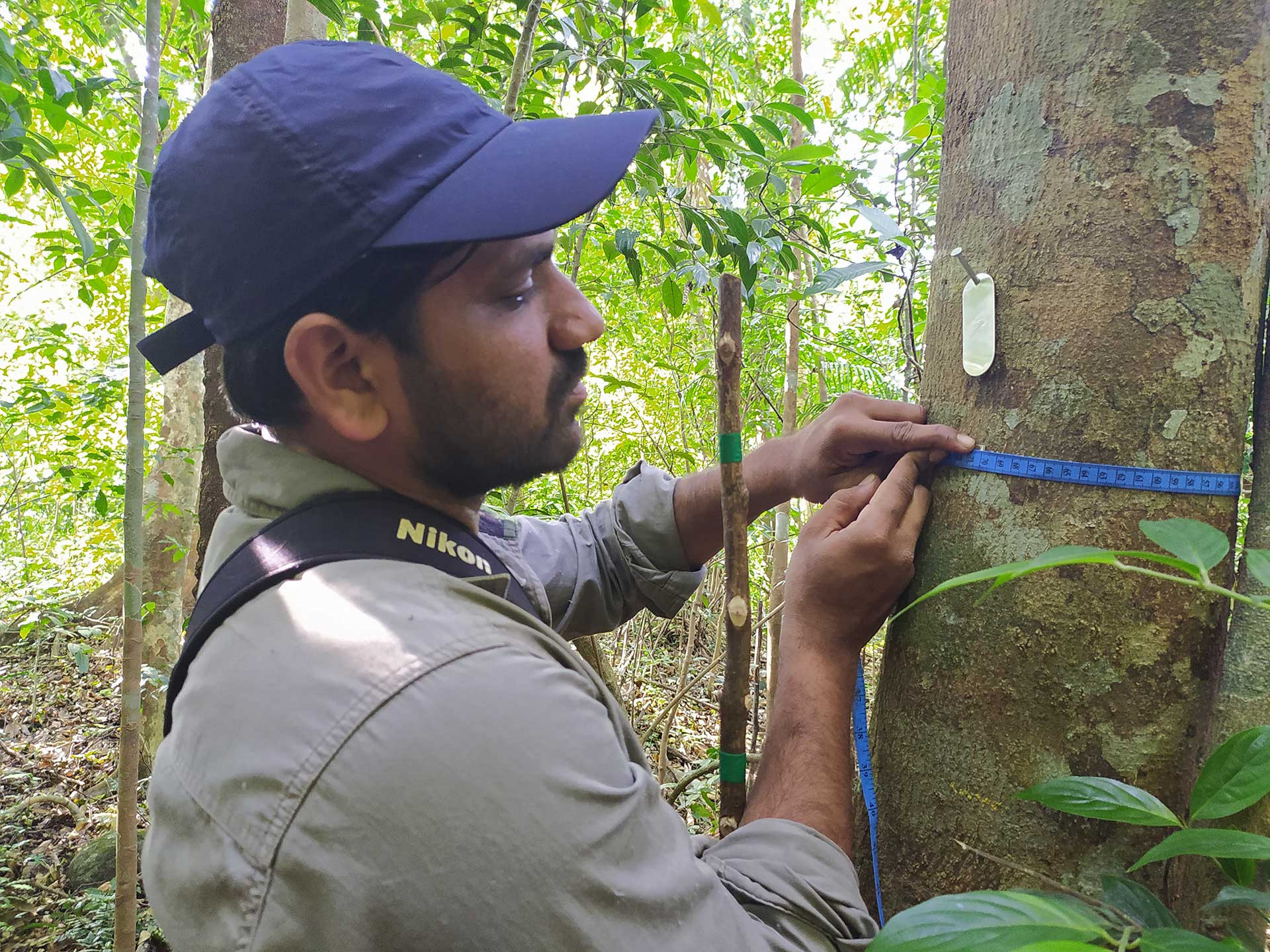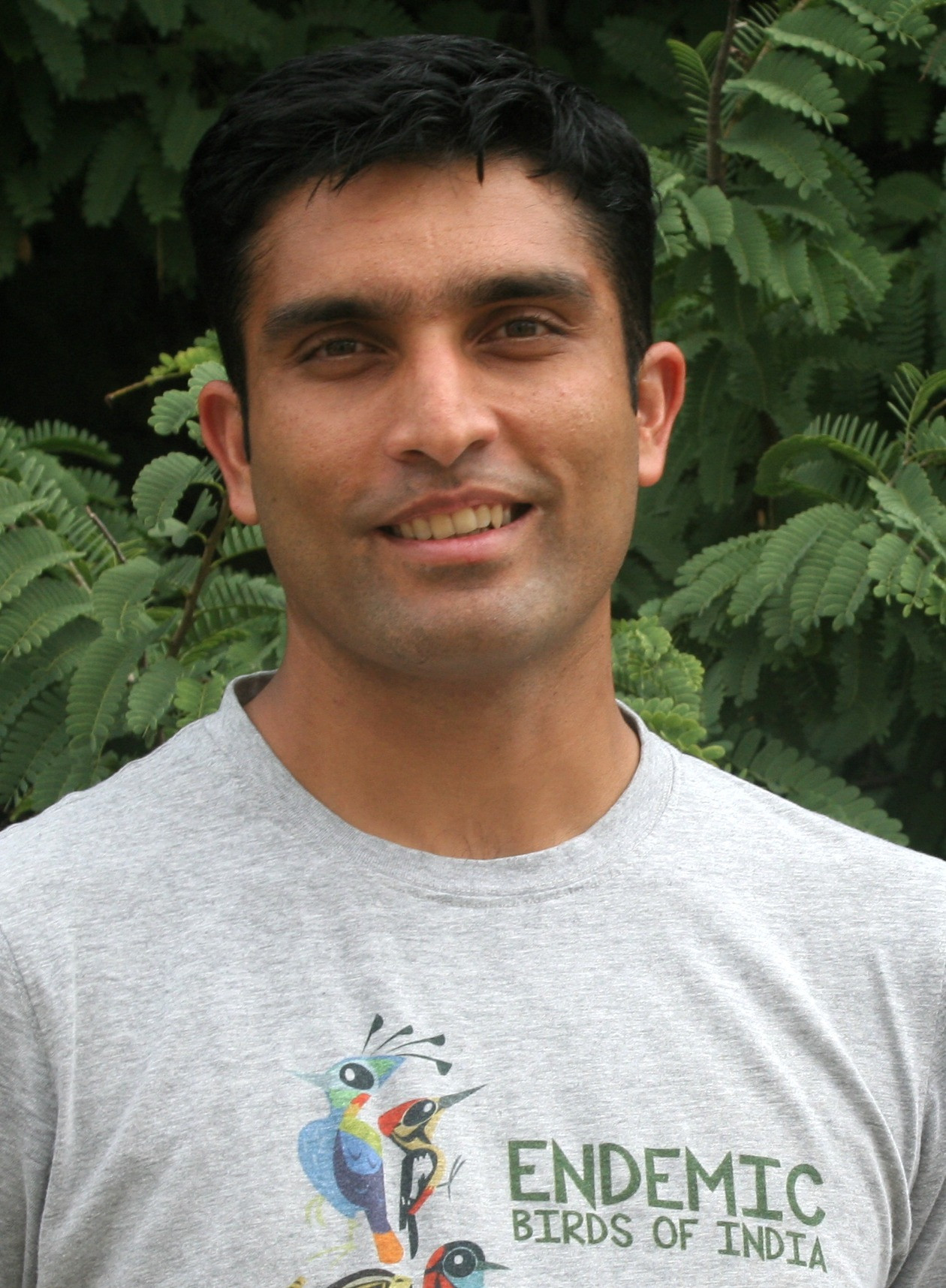Featuring Anamalai Rainforest Restoration in the South Western Ghats Montane Rainforests ecoregion.
Stories about restoration are like hair clinic advertisements—neither is complete without a compelling before-after photo comparison. Photography using standardised locations, orientations and scale references is an elegant and impactful tool for chronicling the evolution of a site’s physical appearance and structure following restoration. Alongside images, restoration practitioners and scientists collect various other data that help them evaluate ecosystem recovery and design restoration activities. This article tells the story of restoration-focused research and the role it has played at Reviving the Rainforest—Nature Conservation Foundation’s (NCF) long-term ecological restoration project in the Anamalai Hills.
The protagonist of this story is the vegetation plot. These are pieces of land having fixed dimensions—typically square, rectangular or circular in shape (e.g. a square 20m ✕ 20m plot). Researchers mark plots at randomly or systematically selected locations within an ecosystem. By measuring trees, counting seedlings, weighing leaf litter, collecting soil cores and various other methods of data collection, they learn a lot about the condition and quality of the ecosystems that the plots represent. Some plots might be visited just once, such as when researchers perform rapid assessments at multiple locations within a single landscape. Others, such as long-term intensive monitoring plots, can outlive entire careers. For example, researchers in the Long-term Ecosystem Monitoring Network (LEMoN-India) collect data at least twice a month from hectare-sized plots (typically 100m x 100m), and have done so for nearly a decade. Long-term plots are like a finger on an ecosystem’s pulse—tracking the growth, death and renewal of plant populations and the capture and release of carbon by plants and soil over many years.
Nearly 25 years ago, NCF ecologists Divya Mudappa and TR Shankar Raman took the first steps for rainforest restoration in the Anamalai Hills by encouraging multiple tea and coffee plantation companies to recognise and protect rainforest fragments on their properties as biodiversity reserves. But they observed that such fragments were often highly degraded. Many were logged in the past, resulting in opened-up canopies under which Lantana camara and other non-native plants had gained a robust foothold. Others were planted with Eucalyptus and other non-native commercial species. Divya and Shankar understood that protection alone was not enough for these fragments—they would also need to be ecologically restored. The important questions were: What were the ecological characteristics of the rainforests they were aspiring to recreate? Crucially, after removing weeds, what tree species should they plant?
Divya and Shankar partnered with botanists from Pondicherry University to study the structure and floristic composition of mid-elevation (800-1400m above sea level) rainforests in and around the Valparai Plateau—a 220sq.km. landscape within the Anamalai Hills that was to become the epicentre of their restoration efforts. The team set up 110 vegetation plots in which they identified, counted and measured trees, lianas and understorey plants. They found that the least disturbed rainforests—within the Anamalai Tiger Reserve—had the most trees, the largest trees, and the greatest tree diversity per plot. These were the benchmark conditions that Divya and Shankar dreamed the presently degraded fragments could one day resemble. Plots in two degraded fragments, by contrast, had fewer smaller trees, poor diversity, and a profusion of weeds, illuminating some of the challenges that restoration would need to overcome.
Restoration activities gained momentum between 2000 and 2004. Divya, Shankar, and a growing team of researchers and field assistants set up a rainforest tree nursery in a space provided by a partner company. As the seedlings grew, they initiated restoration over nearly four hectares spread across 10 degraded sites. Alongside seed collection, nursery work, weed clearing, and restoration tree planting, the team carefully monitored the survival and growth of the planted tree and liana saplings.
Regular monitoring helped improve their restoration efforts in many ways. It underscored the importance of carefully removing weeds from a site—to reduce their risk of re-invading and smothering young native trees. It highlighted that naturally occurring native plants and tree seedlings, if carefully protected during weeding operations, can shoot up and provide vital shade for the young planted tree saplings. Crucially, it showed that older (3-5 years) saplings have better survival rates than younger ones, highlighting the merits of investing in growing and strengthening saplings at the nursery before planting.
By 2016, biodiversity reserves protected by tea and coffee companies (mainly Tata Coffee, Parry Agro, and Tea Estates India) had expanded to 1,075 hectares across 35 rainforest fragments on the Valparai Plateau. The NCF team—now joined by the energetic Srinivasan Kasinathan and ex-techie Kshama Bhat—was nearing its 70th hectare of active restoration. Every site had its own trajectory and story, and the team knew each one intimately. There were the highs of seeing the first flowers blooming on the planted trees and the helpless lows of watching years of effort being erased by an hour of fire. And with several sites entering their second decade post-restoration, there was now an opportunity to introspect and evaluate how the restoration efforts were making a difference. Could fragments have recovered with just protection alone, without needing any active restoration?
As someone who mainly studied the degradation of rainforests, I was excited to join the restoration team and study their revival. We reasoned that if restoration was working as intended, then degraded sites that had been restored would be ecologically more similar to benchmark rainforests than degraded sites that had not been restored. We tested this hypothesis by studying trees and birds in restored, not-restored and benchmark rainforests across the Valparai plateau. Enter our protagonist once more: vegetation plots. In addition to the parameters described earlier, the plots came in handy to estimate carbon stocks based on measurements of tree diameter, height, and wood density. The analog for the plot when studying birds is the point count. Here, observers stand for fixed durations at multiple locations within a site counting bird species and estimating their distances from the point of observation. They then crunch the numbers to estimate bird abundances.
We found that restored forests had more trees, denser canopies, greater diversity of native tree species, greater carbon stocks, and more abundant rainforest birds than not-restored forests, although not to the level of the benchmark rainforests. These are encouraging signs that restoration efforts are succeeding at counteracting some of the forces that prevent degraded rainforests from recovering on their own. It also emerged that not all degraded fragments are equally reliant on restoration. Being close to quality rainforest patches appeared to improve prospects for seed dispersal and other processes that can promote natural regeneration and recovery in degraded sites. Such sites might be best simply protected and monitored for signs of natural recovery before investing additional resources towards active restoration. On the other hand, restoration efforts could focus more on isolated fragments, in which seed dispersal and other prerequisites for natural recovery are typically highly compromised.
So far, the evaluations had focused on what are considered early indicators of restoration success, such as whether planted trees survived, how fast they grew, how their planting modified the tree species diversity of a site, and how much carbon they were sequestering. Now we could begin to evaluate a critical mid-to-long-term indicator of restoration success—whether natural regeneration of rainforest trees has increased under the restored canopies. One recent study examined regeneration plots, identifying and counting naturally occurring seedlings in restored, not-restored, and benchmark forests. Another ongoing study is quantifying seed dispersal into these sites using seed-fall net traps.
The results so far are a mixed bag. More seeds disperse into restored sites than not-restored ones, and the former also have more seedlings recruiting in their understories. Occasionally, a golf-ball-sized seed of wild nutmeg lands in a seed-fall trap in a restoration site despite there being no adults of this rainforest species nearby. This indicates seed dispersal by a visiting large frugivorous bird, quite likely the Great Hornbill. But mostly, incoming seeds and seedlings comprise tree species associated with disturbed rainforests, and shade-loving invaders such as robusta coffee and Maesopsis. Restoration appears to have improved conditions for natural regeneration, but whether, or after how much longer, those conditions can help rainforest tree species gain an advantage remains to be seen.
Over the years, restoration research in the Anamalai Hills has shed light on various aspects of what ecological restoration of degraded rainforests can accomplish, but also underscored what it cannot. A clear and crosscutting takeaway is that while restored forests are no doubt better than degraded ones, they come nowhere close to benchmark rainforests on most counts. Destroying existing mature rainforests amounts to an irrecoverable loss of biodiversity and ecological functions that cannot simply be reversed through restoration. Restoration is a tool we must use for reviving ecosystems that are already degraded, but we should not expect restoration (or tree planting) to compensate for further annihilation of intact natural forest ecosystems.












